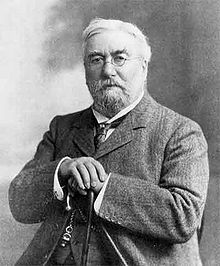Joseph Norman Lockyer
Sir Joseph Norman Lockyer (born May 17, 1836 in Rugby , Warwickshire , † August 16, 1920 in Salcombe Regis , Devonshire ) was an English astronomer and is considered one of the pioneers of modern astrophysics and the founder of archaeoastronomy .
Life
Norman Lockyer became a civil servant in the British War Department in 1857. After a publication on Mars topography , he became a member of the Royal Astronomical Society in 1862 . In 1866 he made a spectral analysis of sunspots . In 1868, independently of the French Jules Janssen , he discovered an unknown line in the solar spectrum . Lockyer and his English colleague Edward Frankland suggested naming the new element helium.
In 1869, Lockyer founded the science magazine Nature , which still exists today. Lockyer remained the editor for 50 years . In 1870 he was appointed secretary of the Royal Commission on scientific instruction and the advancement of science and went on an eclipse expedition to Sicily . In 1871 he was appointed assistant commissioner . In the same year Lockyer traveled to India on an eclipse expedition .
In 1881 Lockyer became professor of astronomy at the Royal College of Science (now part of the Imperial College ). In 1882 he traveled to Africa for another solar eclipse expedition. In 1885 he became director of the newly established solar observatory in South Kensington , which he remained until 1913. In 1912 he also founded his own observatory at Salcombe Hill in Sidcombe , Devon . Lockyer applied the Doppler effect to determine the rotation period of the sun in 1887 and created a theory of stellar evolution . He became Vice President of the Royal Society in 1892 . Since 1873 he was a corresponding member of the Académie des Sciences in Paris and since 1904 of the Russian Academy of Sciences in Saint Petersburg . In 1915 he was elected to the American Academy of Arts and Sciences .
He is known as one of the earliest representatives of archaeoastronomy . After he noticed the east-west orientation of many temples on a trip to Greece in 1890, he systematically checked the astronomical orientation in Egypt as well. B. at the Amun temple in Karnak an alignment to sunrise on midsummer day. He found further orientations to the star Sirius in Egypt. Lockyer published his observations in his book The Dawn of Astronomy in 1894 . In 1901 he determined the age of Stonehenge to be 1680 BC. He assumed that the so-called heel stone was precisely aligned with the sunrise on midsummer's day and calculated the shift in the sunrise direction due to the precession movement of the earth's axis. This age has been confirmed for the latest, extreme stone setting.
The lunar crater Lockyer and the Mars crater Lockyer are named after him.
On June 22, 1897 he was knighted as Knight Commander of the Bath .
Works (selection)
- Elementary lessons in astronomy . London (1868)
- Spectrum analysis as applied to the sun . (1872)
- The spectroscope and its applications . (1873)
- Why the earths chemistry is as it is . (1877)
- Report to the committee on solar physics on the basic lines common to spots and protuberances . (1880)
- Meteoric hypothesis . (1890)
- Rules of golf . (1896)
- Total eclipse of the sun, May 28, 1900 . (1902)
literature
- AL Courtie: Sir Norman Lockyer, 1836-1920 . In: Astrophysical Journal 53, 1921, ISSN 0004-637X , pp. 253-248, bibcode : 1921ApJ .... 53..233C .
- Arthur Jack Meadows: Science and Controversy: a Biography of Sir Norman Lockyer . Cambridge, Massachusetts: MIT Press, 1972. ISBN 0-230-22020-7
- George A. Wilkins: Sir Norman Lockyer's Contributions to Science . In: Quarterly Journal of the Royal Astronomical Society (QJRAS) 35, 1994, ISSN 0035-8738 , pp. 51-57.
Web links
- Publications by JN Lockyer in the Astrophysics Data System
- Obituaries for JN Lockyer in the Astrophysics Data System
Individual evidence
- ↑ http://www.pdavis.nl/Eclipse.htm
- ^ List of members since 1666: Letter L. Académie des sciences, accessed on January 15, 2020 (French).
- ^ Foreign members of the Russian Academy of Sciences since 1724. Joseph Norman Lockyer. Russian Academy of Sciences, accessed October 1, 2015 .
- ↑ Lockyer, FC Penrose: An attempt to ascertain the date of the original construction of Stonehenge . In: Proceedings of the Royal Society of London 69, 1901, pp. 137-147. Stonehenge and Other British Monuments Astronomically Considered , 1906
- ↑ Knights and Dames: KIN-LYV at Leigh Rayment's Peerage
| personal data | |
|---|---|
| SURNAME | Lockyer, Joseph Norman |
| BRIEF DESCRIPTION | English astronomer |
| DATE OF BIRTH | May 17, 1836 |
| PLACE OF BIRTH | Rugby , Warwickshire |
| DATE OF DEATH | August 16, 1920 |
| Place of death | Salcombe Regis , Devonshire |
